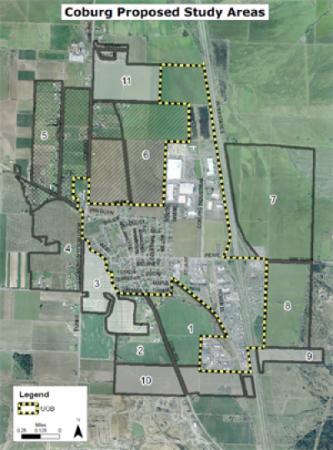Coburg UGB Expansion Analysis
Project Background
Planning for Coburg’s Future
How can Coburg accommodate future growth while retaining its small town atmosphere and retaining its overall quality of life? How should the city’s land use planning adapt to accommodate approximately 2,000 new residents that are forecasted over the next 20 years? Where should these new residents live and work? Depending upon where new housing or employment centers are planned, how will transportation and government services need to change?
These questions are all part of the planning process that was completed in the City of Coburg, as part of what the city calls the Urbanization Update. The primary purpose of the Coburg Urbanization Update is to estimate the land needed to accommodate residential and employment growth over the next 20 years, and determine whether the city has sufficient land within its current Urban Growth Boundary (UGB) to meet the estimated land needs.
Study Findings
Based on state requirements and technical analysis, the study shows that the city does not have enough land to meet the minimum growth requirements and will need to expand the boundaries of the UGB to meet the forecasted demand. Through this process the city evaluated different growth scenarios, and determined how best to distribute forecasted growth. After a year-long public process, on May 11, 2010, Coburg City Council adopted the Study Update with a preferred growth scenario. The preferred alternative will be used for future long-range planning and provides the standard analysis necessary if a land owner outside the existing UGB is interested in incorporating their land inside the UGB. The City of Coburg has no short-term plans to initiate expansion of the urban growth boundary at this time.
Previous Expansions
The City of Coburg last evaluated its land needs during 2003 and 2004 as part of the Coburg Crossroads community visioning project. Many of the recommendations in Coburg Crossroads were incorporated into the Coburg Comprehensive Plan (adopted 2006) and Zoning Code (adopted 2005). The latest change to Coburg's UGB occurred as part of this process when the city added approximately 30 acres to the boundary to address the need for additional commercial lands. Further implementation of the recommendations were halted at that time due to the additional planning needed for Coburg’s wastewater system.
Study Update Inclusions
The Coburg Urbanization Study Update includes:
- An inventory of buildable lands within the city’s UGB
- An estimate of need for land for residential uses, an estimate of need for land for non-residential uses (primarily commercial and industrial, but also public)
- A determination of whether the city has sufficient land within the UGB to meet the estimated residential and non-residential needs
The 2003 Coburg Crossroads project and the Comprehensive Plan and Zoning Code updates resulted in a great deal of stakeholder and public feedback and information. The themes and principles that arose from that process are being utilized and carried forward in this Study Update. The project began in January 2009 and was adopted in May 2010.
Technical Advisory Committee
As in previous planning efforts, community engagement is an essential part of the study to keep stakeholders informed about the progress of the assessment and to provide opportunities for public input in the assumptions used in the assessment. The Technical Advisory Group was composed of community members as well as State and County professionals. This committee included:
- Mike Watson, Coburg City Councilor
- Cathy Engebretson, Coburg Planning Commissioner
- Roxann Emmons, Coburg Chamber of Commerce
- Jack Harris, Coburg Public Works
- Petra Schuetz, Project Manager and Coburg Planning Director
- Stephanie Schulz, Planner, Lane County Land Management Division
- Ed Moore, Area Representative, Department of Land Conservation and Development
All meetings were open to the public, and citizens were encouraged to attend. In addition, LCOG hosted a Public Open House to review the preliminary findings of the study on November 18, 2009. A number of additional town halls were held in conjunction with the wastewater system planning. Attendance varied from 35-150 people.

